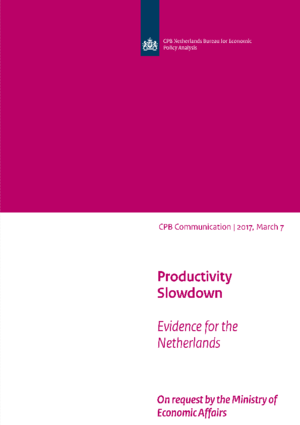Productivity Slowdown - Evidence for the Netherlands
The productivity slowdown is a much discussed topic. Most OECD countries have experienced a slowdown in recent decades, but show different patterns. For the US, studies find that productivity growth accelerated after around 1995, after which it slowed down again around 2000. The ICT revolution is often mentioned as an explanation for this pattern. For other countries, studies find a productivity slowdown that starts later than in the US. In addition to the ICT revolution, a number of other explanatory factors are mentioned in the literature, such as education or the age structure of the population. This paper analyses how The Netherlands compares to other countries in terms of the productivity slowdown. It also includes a comparison of different sectors and tests possible explanatory variables.
Our results show a widespread productivity slowdown. There is some variation in the timing of the slowdown, but all the countries in our datasets seem to experience historically low productivity trends in recent years. We find that labour productivity growth in the Netherlands dropped from 1970 onwards, with a notable bump around 2000. This is not caused by cyclical factors, such as business cycles, the Great Recession and bank crises. We find evidence, although no hard proof, that the slowdown of the past decade may consist of a return to a ’normal’ growth rate after the ICT boom in the late 1990s. Our regression results show that before the Great Recession, highly intensive ICT sectors contributed significantly more to productivity growth than other sectors. When the period is extended until 2015, this significant effect disappears. When we include explanatory variables for this slowdown, almost none turn out to be significant, except share of women in the workforce, education level, the contribution of ICT capital services to value added growth (ITK) and the contribution of non-ICT capital services to value added growth(non-ITK intensity).
Various methods are used to study the productivity slowdown. Since observed productivity growth is subject to significant period-to-period volatility, the underlying trend should first be isolated before conclusions can be drawn about the growthrate. The methods commonly used in the literature range from simple averages to more sophisticated technical techniques (such as state space models or SSM). A much used method to separate cyclical components from structural trends is filtering, of which the Hodrick-Prescott (or HP) filter is the most well-known. We apply the HP filter and compare the results with those obtained by the more sophisticated SSM and find the results show little difference. Not only are we interested in the structural trend of productivity growth, we also would like to know whether there are structural breaks in the trend, and when these occurred. To detect these, we use the Bai and Perron, (1998) statistical methodology. We only find one significant trendbreak, in 1978.
We investigate productivity slowdown for OECD countries between 1970 and 2014. A number of datasets exist that contain labour productivity growth data. We use the KLEMS and OECD databases, which are most comprehensive. For the SSM, we use the Total Economy Database (TED). Data for the analysis on the Dutch productivity slowdown was obtained from Statistics Netherlands. We combined several datasets to generate a complete dataset (in terms of available variables, countries, sectors and years). However, not all datasets are compatible, limiting our analysis of explanatory factors.
Downloads
Authors




